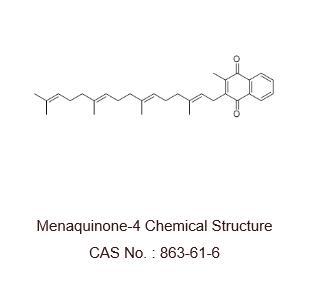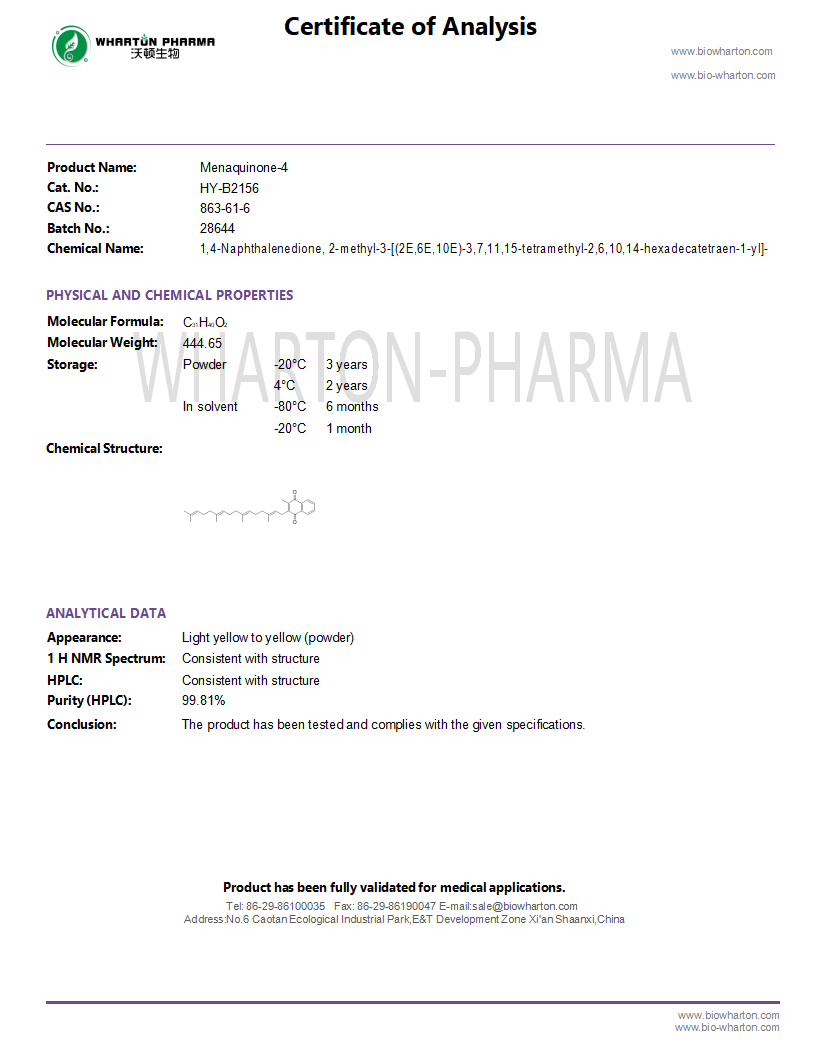
Vitamin K2 MK4
Packaging Details:Powder:1kg/bag, 5kg/bag, 5kg/tin 10kg/tin, 25kg/tin Oil: 5kg/tin, 25kg/tin
| Description | Menaquinone-4 is a vitamin K, used as a hemostatic agent, and also a adjunctive therapy for the pain of osteoporosis. | ||||||||||||||||
| In Vitro | Menaquinone-4 (MK-4, 0, 1, 5, 10 μM) increases the ALP activity in Caco-2 cells. Menaquinone-4 (1 μM) significantly increases intensities of hSI expression[1]. | ||||||||||||||||
| In Vivo | Menaquinone-4 (K2, 0.2 g/kg diet) in HF-K2 group produces epididymal fat in C57BL/6J mice, and also increases the bone density of mice[2]. | ||||||||||||||||
| Preparing Stock Solutions |
Please refer to the solubility information to select the appropriate solvent. |
||||||||||||||||
| Cell Assay [1] |
Caco-2 cells are plated at a density of 2-5 × 104 cells/cm2 onto a 35-mm dish. Cells are incubated for 2 to 3 days until 60%-70% confluency, and desired concentrations of Menaquinone-4 (0, 1.0, 5.0, and 10.0 μM) are added. The final concentration of the vehicle is 0.1% of the culture medium, and the culture medium is changed twice a week. Cells are assayed on days 0, 3, 7, and 11 after the addition of Menaquinone-4[1]. MCE has not independently confirmed the accuracy of these methods. They are for reference only. | ||||||||||||||||
| Animal Administration [2] |
Menaquinone-4 is prepared in diet.
Forty-two male, 4-week-old C57BL/6J mice provided with feed and drink ad libitum. For environmental adaptation, the animals had 1 week of circulation, and then are provided with the experimental diet after being randomly divided into 6 groups (7 animals in each group; randomized block design). The AIN-93G diets consist of a normal diet (N), normal diet + vitamin K1 (N-K1), normal diet + vitamin Menaquinone-4 (N-K2), 45% high-fat diet (HF), 45% high-fat diet + vitamin K1 (HF-K1), and a 45% high-fat diet + vitamin Menaquinone-4 (HF-K2). The vitamin K1 and vitamin Menaquinone-4 contents are 200 mg/1,000 g, and the diet is provided in pellet form. Body weight is measured once a week, and the food efficiency ratio (FER) is calculated by dividing the increased body weight from day 1 to the final day by the food intake amount during the experiment period. For fat amount measurement, the epididymal fat, perirenal fat, and retroperitoneal fat are extracted from dead animal subjects, are washed with 0.9% NaCl, dried by filter paper, and then are weighed[2]. MCE has not independently confirmed the accuracy of these methods. They are for reference only. |
||||||||||||||||
| Molecular Weight | 444.65 | ||||||||||||||||
| Formula | C₃₁H₄₀O₂ | ||||||||||||||||
| CAS No. | 863-61-6 | ||||||||||||||||
| SMILES | O=C1C(C)=C(C/C=C(C)/CC/C=C(C)/CC/C=C(C)/CC/C=C(C)\C)C(C2=C1C=CC=C2)=O | ||||||||||||||||
| Storage |
|
||||||||||||||||
| Shipping | Room temperature in continental US; may vary elsewhere | ||||||||||||||||
| Solvent & Solubility | DMSO
* “<1 mg/mL” means slightly soluble or insoluble. “≥” means soluble, but saturation unknown. |

